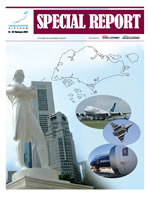
The Singapore Air Show 2012 will be a crucial notch on the calendar for the global aviation and defense industries. Our Special Report for the Singapore Air Show comes at a time when Asia is becoming ever more important to the global aviation and defense industries. With defense spending in Europe and the US being held back as governments look to rein in spiraling debt levels, defense manufacturers are looking to Asia to take up the slack. The Middle East, India and the entire Asia-Pacific region are becoming increasingly important to military suppliers and this will no doubt be in evidence in Singapore.
It can already be seen at other regional events such as the Seoul Air Show, LIMA and AeroIndia, to name but a few. European, North American and others – including a growing indigenous element – are increasingly seeing Asian shows as crucial elements of their marketing strategy. And the Singapore Air Show is the regional highlight – at least for the Asia- Pacific region.
Download: Singapore Special Report
It is a similar story with commercial aviation. Of IATA’s 2011 full year forecast of US$6.9 billion net profit, some US$3.3 billion of that is expected t o come from the Asia-Pacific region. Europe and North America will no doubt recover over time, but the long-term picture is of Asia being on a par with the other two regions.
Aircraft manufacturer Boeing estimates that the Asia-Pacific region will require some 11,450 new aircraft in the 2011 to 2030 time period, around a third of new deliveries worldwide. And Asia-Pacific airlines will spend US$1,510 billion (S$1,950 billion) almost as much as European and North America combined, reflecting the fact that the region has and will have a higher proportion of long-haul aircraft.
So, whether its defence or commercial, Asia is and will be the place to be. If companies haven’t already got a presence in the region, they soon will have if they want to be a global player and tap into the most dynamic market.
This may well involve partnerships – the list of joint ventures in the region is growing and is probably going to be even longer by the time the Air Show has finished.
Having the ability not just to sell equipment into the region but also to service it as well, is becoming increasingly crucial. Russian Helicopters’ decision to set up a representative office in Vietnam last year is just one example of this.
“One of the main goals of this opening is to gain access to broader markets, search for new partners and new cooperation modes in Southeast Asia and Australia,” says the Russian manufacturer.
It will also mean that the manufacturer is closer to the customer and can provide the just-in-time style support that modern operators require. “By opening a representative office in Hanoi we will be able to establish an after sale support system for rotorcraft of Russian make that will be very accessible and comfortable for operators in this region,” says Russian Helicopters CEO, Dmitry Petrov.
With Asia set to keep on growing – not withstanding any possible short term challenges and uncertainty – it will increasingly be a key part of the strategic planning for aviation and defense companies.
Company Highlights:
- Alenia Aermacchi’s C-27J: The TACTICAL Transport Aircraft
- The Wide Range – Bombardier Aerospace Heritage
- Elettronica and the art of Innovation
- IAI Introduces the ‘Total Connectivity Solution’ at the Singapore Airshow 2012
- Northrop Grumman Scalable Agile Beam Radar (SABR)
- Dependable Engines: Pratt & Whitney
- Raytheon AESA Radars – Technology Solutions Mapped to Regional Needs
- RUAG Aerospace Plans to Set MRO Partnership in Malaysia
- Russian Helicopters Expand to Vietnam
- Telephonics: Integrated Surveillance and Communication Systems



















